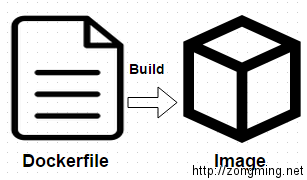使用 Dockerfile 创建镜像
2016-03-15 by dongnan
开始之前
使用一个 Java项目的示例,介绍下如何使用 Dockerfile 创建一个自定义Java镜像,以及在 Dockerfile 中常用的一些指令。

环境描述
容器镜像: openjdk:8-jre
容器系统: debian 8 (jessie)
Docker主机: Ubuntu Server 16.04
CI工具: Jenkins & Maven
项目程序: 编译好的 bms.jar 包
操作步骤
准备 Dockerfile 文件
# 执行命令
cat bms/Dockerfile
# bms
FROM openjdk:8-jre
MAINTAINER dongnan
# apt
COPY conf/sources.list /etc/apt/sources.list
RUN apt-get update && apt-get install -y \
wkhtmltopdf xvfb \
&& apt-get clean && rm -r /var/lib/apt/lists/*
# env
ENV TZ=Asia/Shanghai LANG=C.UTF-8
# package
COPY src/bms.jar /root/bms.jar
# workdir
WORKDIR /root/
# statement Port
EXPOSE 8080
# cmd
CMD ["java","-jar","/root/bms.jar"]
构建镜像
守护进程读取 Dockerfile 文件然后按照文件中的指令顺序执行。
构建镜像时会一层层构建,前一层是后一层的基础,每一层构建完就不会再发生改变,后一层上的任何改变只发生在自己这一层。
# 执行命令
docker build -t bms:0.0.1 .
Sending build context to Docker daemon 2.048 mb
# ...省略
Successfully built cd34135ed904
注意: docker build 命令最后有一个. 表示当前目录,而 Dockerfile 就在当前目录,是在指定上下文路径。
验证镜像
尝试使用这个镜像创建一个容器,如果容器正常运行说明构建成功。
docker run --name test -tid bms:0.0.1
分层存储
镜像使用的是分层存储容器也是如此,每个容器运行时是以镜像为基础层,在其上创建一个当前容器的存储层。
容器运行后修改了容器内的文件,也就是改动了容器的存储层,通过 docker diff 命令看到具体的改动。
docker container diff test
C /root # C 改变
A /root/logs # A 添加
A /root/logs/bms.log
C /tmp
A /tmp/tomcat-docbase.1383372449962167136.9290
Dockerfile 常用指令
Dockerfile 中每一个指令都会建立一层,上面的示例创建了9层镜像。
FROM指令用于指定基础镜像,一个有效的Dockerfile必须使用FROM做第一个指令。MAINTAINER指令用于设置作者信息。RUN指令是用来执行命令的,并将结果提交到当前镜像层。ENV指令设置环境变量,无论是后面的其它指令,还是运行时的容器,都可以直接使用这个环境变量。COPY指令将从构建上下文目录中<源>文件/目录复制到新的一层的镜像内的<目标>位置。ADD指令和COPY指令功能基本一致。但是在COPY基础上增加了一些功能,例如ADD会做自动解压工作。WORKDIR指令用来指定工作目录(当前目录),如该目录不存在则会帮你建立目录。EXPOSE指令是声明运行时容器提供服务端口,这只是一个声明,在运行时并不会因为这个声明就会开启这个端口。CMD指令用于指定默认容器主进程的启动命令(容器就是进程,在启动容器的时候需要指定所运行的程序及参数)。
帮助
docker build --help
Usage: docker build [OPTIONS] PATH | URL | -
Build an image from a Dockerfile
Options:
--add-host list Add a custom host-to-IP mapping (host:ip)
--build-arg list Set build-time variables
--cache-from strings Images to consider as cache sources
--cgroup-parent string Optional parent cgroup for the container
--compress Compress the build context using gzip
--cpu-period int Limit the CPU CFS (Completely Fair Scheduler) period
--cpu-quota int Limit the CPU CFS (Completely Fair Scheduler) quota
-c, --cpu-shares int CPU shares (relative weight)
--cpuset-cpus string CPUs in which to allow execution (0-3, 0,1)
--cpuset-mems string MEMs in which to allow execution (0-3, 0,1)
--disable-content-trust Skip image verification (default true)
-f, --file string Name of the Dockerfile (Default is 'PATH/Dockerfile')
--force-rm Always remove intermediate containers
--iidfile string Write the image ID to the file
--isolation string Container isolation technology
--label list Set metadata for an image
-m, --memory bytes Memory limit
--memory-swap bytes Swap limit equal to memory plus swap: '-1' to enable unlimited swap
--network string Set the networking mode for the RUN instructions during build (default "default")
--no-cache Do not use cache when building the image
--pull Always attempt to pull a newer version of the image
-q, --quiet Suppress the build output and print image ID on success
--rm Remove intermediate containers after a successful build (default true)
--security-opt strings Security options
--shm-size bytes Size of /dev/shm
-t, --tag list Name and optionally a tag in the 'name:tag' format
--target string Set the target build stage to build.
--ulimit ulimit Ulimit options (default [])
参考
内容参考自 Docker — 从入门到实践
强烈推荐作为 Docker入门技术书籍。